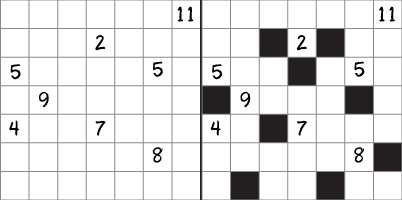Feel free to share
 Using this site means trees will be planted. ^.^
Using this site means trees will be planted. ^.^
(Find out more)
Kurodoko
Kurodoko is a Nikoli puzzle in which the aim of the game is to place black cells on a grid by finding their correct positions, in some ways similarly to how Minesweeper is played.
Kurodoko can be played on any sized grid, but the bigger the grid the bigger the challenge often becomes. The difficulty does depend a lot on the number hints and the amount of black cells however.
The rules are as follows:
- Find the correct positions for black cells and add them to the grid.
- The numbers on the grid indicate how many white cells can be seen in horizontal and vertical directions. This includes the cell the number occupies. The view extends to either the first black cell or the edge of the grid, whichever comes first.
- Numbered cells can never be a black cell.
- Black cells can only touch diagonally (corners touch), but never horizontally or vertically.
Standard version
Kurodoko can seem like a daunting puzzle to those less puzzle enthusiastic, but they're generally not all that hard to complete. Some simply take a while.
The best places to start are usually large numbers, tiny numbers, and number clusters. They often allow for deductions to be made, sometimes through a little trial and error, and from there on the rest of the puzzle becomes more and more solvable.

Converting it to an RPG setting.
Kurodoko offers a lot of adaptation possibilities, albeit in often similar ways. The locations of mines in a mine field, traps in a room, buried treasure on an island, and so on. It's often about location, even when you think vertically instead of horizontally. For example, the locations of the right safety deposit boxes in a wall of them, the weak spots in a defensive wall, and so on.
There are more adaptations however. With some planning and perhaps some abstract thinking you could hide symbols in the black cells, show the touches on a keyboard or number pad, reveal a path alongside a wall, and so on.
I went with a simple pitfall location adaptation for my example. My character finds herself in a large room. She knows some of the floor tiles are fake, but the exact locations of them is hidden within the number clues she's been given. She has information on how to solve a Kurodoko puzzle, so she should be safe.

As long as she figures out the puzzle, or gets incredibly lucky by simply trying a route blindly, she will make it from the bottom of the grid to the top. If not she will fall through a gap in the floor, bringing her to who knows where. The where and what of where she goes offers plenty more opportunities of creative adaptations. A floor without loot, a floor with monsters, the dark abyss, or, perhaps most terrifying of all, a different floor with another Kurodoko puzzle. The horror!
In most RPG settings this puzzle could be solved in plenty of other ways. Testing each tile with a heavy object (no, not the party's dwarf!) tied to a rope would be an obvious one. If players do this I'd let them, but some may try to find ways around this. Perhaps by using electric fields instead of pitfalls, or hidden monsters which activate upon touch.